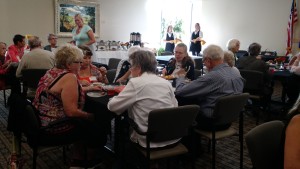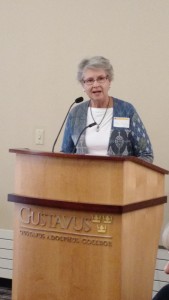In case you missed it, here is Mim’s book review about The Immortal Life of Henrietta Lacks:
I congratulate the Reading in Common committee for choosing such a meaningful book for our first-year students and our Gustavus community to discuss and learn from.
I am challenged tonight, to talk about such a book. When Lynn asked me if I would present a review at this occasion, I thought, Um, how many hours do I get? Not for my sake, but to do the book justice. I had read it over a year ago with my book club, and I knew I would have to do some serious “reviewing” before I could review it. I ended up re-reading the whole thing! And I found, as often is the case, that the second reading was just as fascinating, and even more rewarding and enriching, than the first. I’ll likely read it again sometime, and love it even more.
Why is it a challenge to talk about? There is simply so much to learn and to say. For one, the book is about race, and how a poor, disadvantaged black family from the Virginia and Maryland area were, in a way, taken advantage of, used without their knowledge or permission, denied recognition and reward, and generally treated as if they, their identity and their feelings were of little or no consequence in the face of a great scientific marvel that began with their lovely Henrietta.
It’s a book about science, with entire chapters devoted to doctors, cell research, laboratories, experimentation, and the incredible advancement of knowledge that all began with cancer cells taken from the cervix of a poor black woman, Henrietta Lacks. Those cells turned out to be almost surrealistically immortal, in that they did not die in a lab culture, as human cells always did, but stayed alive, multiplied astonishingly, and were propagated, sold and used by the billions to aid in science and health research, in laboratories all over the world.
They are called HeLa, H-E for Henrietta, L-A for Lacks; cell collections were often labeled by initials to acknowledge their donors. But donor implies the witting sharing or giving of one’s property. Henrietta, a vivacious and attractive mother of five, who loved stylish clothes, nail polish, and dancing, a poor, black woman, sometime tobacco farmer, went into Johns Hopkins in Baltimore in February of 1951, because she knew something was wrong, and had been for over a year: a hard lump was growing inside her. From her examination that day, her doctor kept (without her permission or knowledge) cell samples scraped from a cervical tumor, and those HeLacells became nothing less than phenomenal.
Author Rebecca Skloot tells us [p.4]: “If we went to almost any cell culture lab in the world and opened its freezers…we’d probably find millions—if not billions—of Henrietta’s cells in small vials on ice. Her cells were part of research into the genes that cause cancer and those that suppress it; they helped develop drugs for treating herpes, leukemia, influenza, hemophilia, and Parkinson’s disease; and they’ve been used to study lactose digestion, sexually transmitted diseases, appendicitis, human longevity, mosquito mating, and the negative cellular effects of working in sewers. Their chromosomes and proteins have been studied with such detail and precision that scientists know their every quirk. Like guinea pigs and mice, Henrietta’s cells have become the standard laboratory workhorse. ‘HeLa cells were one of the most important things that happened to medicine in the last hundred years.’ ”
Henrietta’s medical treatment was not science at its best. She endured what seems like the most perfunctory radiation and other treatments in the “colored” ward, and suffered terribly, burned and scarred, from being implanted with radium. She died in October 1951. “During the eight months that she was dying of cancer, the HeLa cells so thoroughly eclipsed her that a lab assistant at her autopsy glanced at her painted red toes and thought: “Oh jeez, she’s a real person. . . . I started imagining her sitting in her bathroom painting those toenails, and it hit me for the first time that those cells we’d been working with all this time and sending all over the world, they came from a live woman. I’d never thought of it that way.”
It’s a book about family and the ties that bind. The Lackses were poor, uneducated, descendants of slaves, denied basic opportunities as so many poor blacks were in that time and place—for example, several of the children had undiagnosed deafness, or degrees of it, a deficit that made it almost impossible for them to learn and succeed in the poor schools they did attend as children. Because they were raised not to challenge authority nor to ask questions, they kept quiet, school became pointless, and they dropped out. After Henrietta died, her little children weren’t told what had happened—don’t ask questions—and grew up without a mother’s nurturing love and despite abusive “care,” by unloving relatives and in-laws of relatives. It was a hardscrabble family, often dysfunctional but always connected.
A major force in the book is Deborah, one of Henrietta’s daughters, who was befriended by author Skloot as she slowly and patiently, over a decade, researched the family and the cells and built a trusting relationship with Deborah. Deborah was the force that held the damaged family together as best she could, dedicating herself to the next generations of children, determined that they would get an education—and most of all, despite her deep mistrust of educated white folks who come knocking to find out their story, she dared eventually, with Skloot’s encouragement, to look into the story, the facts, the existence, of her mother’s phenomenal “afterlife” as donor of the HeLa cells.
It’s a book about faith: Rebecca Skloot tells us she grew up white and agnostic, her roots half New York Jew and half Midwestern Protestant. Deborah was a deeply religious black Christian from the south whose family tended toward preaching, faith healings, and sometimes voodoo, and Deborah believed fervently that Henrietta’s spirit lived in her cells, controlling the life of anyone who crossed its path: [(p. 7] “ ‘How else do you explain why your science teacher knew her real name when everyone else called her Helen Lane?’ Deborah would say. ‘She was trying to get your attention.’ This thinking would apply to everything in my life: when I married while writing this book, it was because Henrietta wanted someone to take care of me while I worked. When I divorced, it was because she’d decided he was getting in the way of the book. When an editor who insisted I take the Lacks family out of the book was injured in a mysterious accident, Deborah said that’s what happens when you piss Henrietta off.”
One reviewer wrote, “Rebecca Skloot introduces us to the ‘real live woman,’ the children who survived her, and the interplay of race, poverty, science and one of the most important medical discoveries of the last 100 years. She presents the science clearly, identifies and tracks the racial politics of medicine thoughtfully and tells the Lacks family’s often painful history with grace. She also confronts the eerie, sort of immortal nature, of the cells themselves, bravely crossing into the spiritual plane on which the family has come to understand their mother’s continued presence in the world.”
It’s a book about injustice and racial bias: [p. X] “Deborah’s Voice … But I always have thought it was strange, if our mother cells done so much for medicine, how come her family can’t afford to see no doctors? Don’t make no sense. People got rich off my mother without us even knowin about them takin her cells, now we don’t get a dime. Iused to get so mad about that to where it made me sick and I had to take pills. But I don’t got it in me no more to fight. I just want to know who my mother was.”
It’s a book that at times reads like a novel, with incredible richness and grace in its storytelling, its narrative flow, its authentic dialogue and creation of scenes. Some chapters are scholarly and scientific, some are journalistic reportage, all show great passion and insight. The author’s versatility is astonishing, and the book is, as they say in the trade, a page-turner. I urge you to read it. More than once.
Thank you for listening, and thanks for coming to this Gustavus Library Associates membership event. GLA is doing wonderful things for the College and its students through the Folke Bernadotte Memorial Library, and your membership dollars buy books—and so much more—to support teaching and learning. Come join us!

